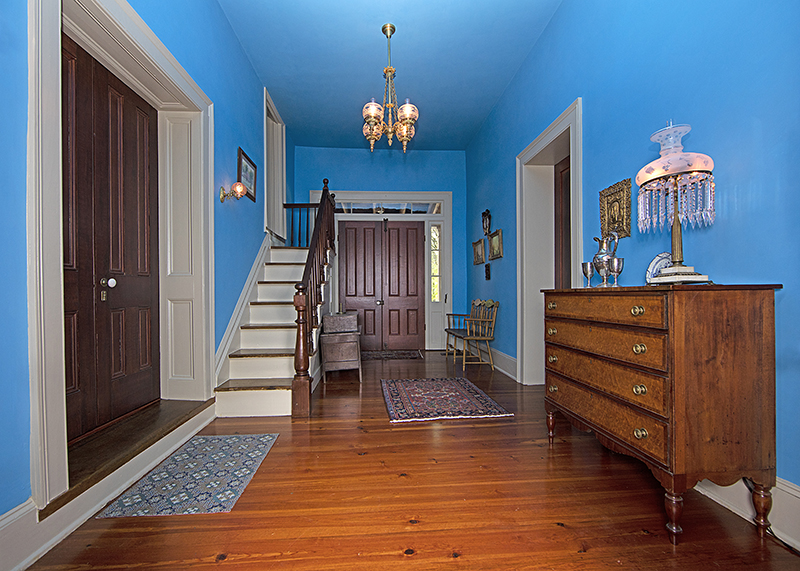Mebane-Nuckolls House


Dogtrot
This hall connects the 1830s cottage on the right (east) with the front of the house, which was built about twenty years later.
In a consistent theme, all of the plaster was removed in the 1980s. The ceiling was also lowered.
We have traces of the original blue wall paint where the plaster abutted the moulding.
The foundation has dropped about an inch. We will jack it up and put support piers in as needed.

Its most distinctive feature is the servants' stair, which connects with the main stairway about halfway up.
Almost all of the original moulding is still in place. The profile running up the servants' stair is the same as in the front of the house, but the baseboard in this hall is not as tall and not rebated.
In addition, it was originally built with a shoe moulding. Instead of being nailed on the outside, as seen on modern houses, ours is integral. It is a larger piece (1 - 3/8" wide x 1 - 1/16" tall), that was square-nailed to the floor. It is dadoed to accept the rabbeted baseboard lying on top.
Here we go again. We really wanted to save the original floor, but there was too much old powderpost beetle and termite damage to the foundation.
This photo shows how it was originally built. We will try our best to redo it in a sympathetic way. But we are not going to rely entirely on the joists being mortised into holes in the walls. As in other rooms, the joist tails had rotted out and the foundation had dropped. So we're going to build piers and have 8x8 cross beams shoring the whole thing up.
Thankfully, our source for rough-sawn white oak timbers is still in business.
While we're at it, we will move the HVAC registers out of the middle of the floor and rewire the whole room. We will relocate the electrical outlets into the wall instead of in the floor, where they filled up with dirt and dust. The wiring will run through conduit, buried in the wall. It had been stapled along the outside of the wall.
Jim has pulled the ceiling out. As before, previous owners had installed darkly-stained bevel siding up there. We will go back with plaster.

Gable end of the oldest brick cottage on the east side of the hall.
This breezeway does not have a ridge beam, but the decking is 1" thick and the joists are massively overbuilt.

Roof structure.
All original.

Instead of running Romex on the outside of the wall as the previous owner had done, we cut a chaseway and rewired with flexible metal conduit. It will then be covered by the plaster.
After some trial and error, we came up with a way to get the electrical boxes plumb and at the correct depth. The shims will come off prior to the plaster work.

In every room thus far, the plaster men have managed to break something. A window pane. A 160-year-old porcelain door knob that matched every other one in the front of the house but unlike any replacement I have looked at.
They have dropped huge amounts of the mud all over the floors and stairwells. And they've managed to fill every electrical box with mortar. It sets up like concrete.
So Bonnie spent hours padding and covering the stair spindles and railing. Since the dust infiltrates the entire house, Jim and Rocky took the better part of a day hermetically sealing everything. In the end, plaster work is worth it. But it is messy!

This photo shows the differences in the first two coats of plaster. The first, originally known as the brown coat, is aka the scratch coat. It is laid with deep grooves so the next coat will have more surface area to bind.

We went back to Cindy and Chris Allen in Massachusetts for this circa 1850 solar chandelier.

One of a pair of sconces from 1850-60.

About the time we finished work on the room, I found this ca 1815 paint-decorated Baltimore settee. So sit down and enjoy yourself.

Paint detail

Completed. Looking west. We found traces of the original blue paint very similar to this along the edges of mouldings. It is rather bold.
We really wanted to save the old flooring, but once again encountered too much structural damage. Fortunately, Butch Cook still has plenty of heart pine from the 1870 cotton warehouse he took down.
The 1670 Massachusetts Bible box sits atop a 1620 English blanket chest.

Looking north.

East side.
The settle is from Baltimore, 1815. The bird's eye maple and mahogany chest is labeled by its maker. Maine, about 1810. Mr. Wheatley has finished grain painting the doors. Bonnie and I drove to Nashville and picked the last of them up two days before this photo was taken. There are 8 doors in this hall!

In 1858, the American firm Russell and Erwin came out with a series of four high-end cast locks named Eagle, Emigrant, Pioneer, and Village. We have placed this one on the door at the top of the servants' stair.

While we're at it, the Eagle lock from the same company is on our bedroom door. Both have the unusual blue swirl mineral knobs.

I've had this lock for several years. It's perfect for the door to the closet under the servants' stair.
174 years old when we gave it a new job.
Forward to Restoration Page 9
Home
 Bonnie R. Warner
Bonnie R. Warner